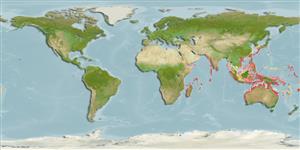>
Eupercaria/misc (Various families in series Eupercaria) >
Lethrinidae (Emperors or scavengers) > Lethrininae
Etymology: Lethrinus: Greek, lethrinia, a fish pertaining to genus Pagellus.
More on author: Valenciennes.
Environment: milieu / climate zone / depth range / distribution range
Ecologie
marien; brak water rifbewoner; standvastig; diepte 5 - 25 m (Ref. 1602). Tropical; 35°N - 30°S
Indo-West Pacific: Indonesia (including eastern Indian Ocean side), northwestern Australia, Philippines, southern Japan, Papua New Guinea and the Caroline Islands. This species has long been recognized as Lethrinus nematacanthus and the name Lethrinus genivittatus misassociated with many other species.
Grootte / Gewicht / Leeftijd
Maturity: Lm ? range ? - ? cm
Max length : 25.0 cm TL mannelijk / geslacht onbekend; (Ref. 2295); common length : 15.0 cm TL mannelijk / geslacht onbekend; (Ref. 2295); max. gerapporteerde leeftijd: 7 Jaren (Ref. 2290)
Dorsale stekels (totaal): 10; Dorsale zachte stralen (totaal): 9; Anale stekels 3; Anale zachte stralen: 8. The only Lethrinus with its 2nd dorsal spine the longest. The inner surface of the pectoral fin may be scaleless, partially covered with scales or densely covered with scales. Body color is tan or brown on the upper sides, white on the lower sides, with three tan or brown stripes. The sides often have scattered irregular black oblique bars and a square black blotch above the pectoral fin and bordering below the lateral line. The head is brown or tan sometimes with several broad, somewhat indistinct vertical and oblique bands (these bands are sometimes composed of fine reticulations). The fins are pale, speckled with small white blotches.
Solitary or in groups (Ref. 90102). Occurs over shallow sandy and seagrass beds, in mangrove swamps, lagoons, channels and outer reef slopes. May enter rivers. Feeds on crustaceans and small fishes. A protogynous hermaphrodite (Ref. 55367). A protracted spawning peak from July to December is recorded in New Caledonia. Smaller and more numerous females than males have been confirmed in Australian populations. Marketed fresh (Ref. 9775).
Levenscyclus en paargedrag
Maturiteit | Voortplanting | Paaien | Eieren | Fecunditeit | Larven
A monandric species (Ref. 55367). Length at sex change = 18.0 cm TL (Ref. 55367). Also Ref. 103751.
Carpenter, K.E. and G.R. Allen, 1989. FAO Species Catalogue. Vol. 9. Emperor fishes and large-eye breams of the world (family Lethrinidae). An annotated and illustrated catalogue of lethrinid species known to date. FAO Fish. Synop. 125(9):118 p. Rome: FAO. (Ref. 2295)
Status op de Rode Lijst van het IUCN (Ref. 130435)
Gevaar voor de mens
Harmless
Gebruik door de mens
Visserij: van minder commercieel belang
Meer informatie
ReferentiesAquacultuurAquacultuurprofielKweeklijnenGeneticaElectrophoresesErfelijkheidZiektesVerwerkingNutrientsMassaconversie
Tools
Speciale rapporten
Download XML
Internetbronnen
Estimates based on models
Preferred temperature (Ref.
123201): 24.7 - 29.3, mean 28.4 °C (based on 2863 cells).
Fylogenetische diversiteitsindex (Ref.
82804): PD
50 = 0.5000 [Uniqueness, from 0.5 = low to 2.0 = high].
Bayesian length-weight: a=0.01349 (0.00868 - 0.02097), b=2.97 (2.85 - 3.09), in cm total length, based on LWR estimates for this species & Genus-body shape (Ref.
93245).
Trofisch niveau (Ref.
69278): 3.7 ±0.0 se; based on diet studies.
Generation time: 1.3 ( na - na) years. Estimated as median ln(3)/K based on 2
growth studies.
Weerstandsvermogen (Ref.
120179): Gemiddeld, minimale populatieverdubbelingstijd 1,4-4,4 jaar (tmax=7; K=0.86).
Fishing Vulnerability (Ref.
59153): Low vulnerability (17 of 100).
Nutrients (Ref.
124155): Calcium = 78.8 [52.0, 133.1] mg/100g; Iron = 1.09 [0.68, 1.75] mg/100g; Protein = 20.5 [17.9, 22.8] %; Omega3 = 0.148 [0.096, 0.231] g/100g; Selenium = 33 [19, 62] μg/100g; VitaminA = 29.6 [6.0, 178.6] μg/100g; Zinc = 3.07 [2.21, 4.16] mg/100g (wet weight);
